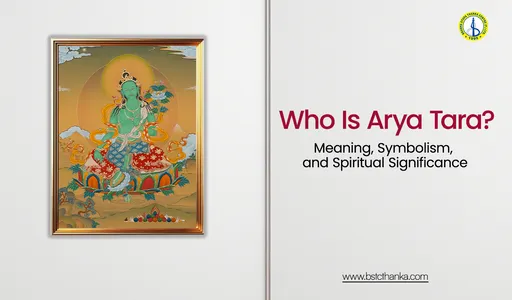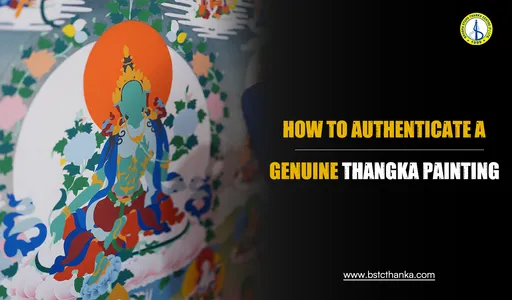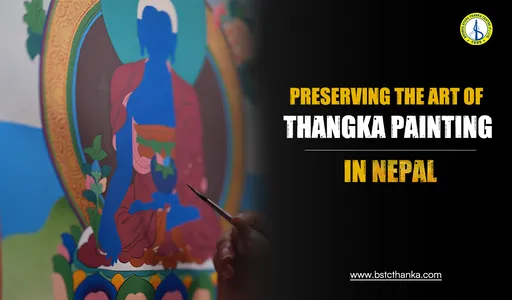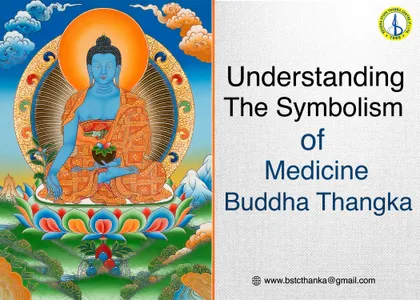.png)
Significance of Thangka Painting in Buddhism
Buddhism is a religion that is often associated with art, and thangka paintings are a significant type of art within the religion. Thangka paintings are used as devotional objects and are often given as gifts to temples or monasteries. The painted images typically depict buddhas, bodhisattvas, or other important figures within the Buddhist pantheon.
The act of creating a thangka painting is itself considered to be an act of devotion, and the painter often enters into a meditative state while working. The end result is an object that is not only aesthetically pleasing, but also spiritually meaningful.
Thangka paintings play an important role in the practice of Buddhism, and can be found in homes and temples throughout the world.
Cultural Significance of Thangka Painting
Thangka painting holds deep cultural significance in Tibetan Buddhism, it serves as a spiritual tool and artistic expression of culture. The hand-painted scrolls depict deities, mandalas (in Mandala Thangka), and religious scenes, used for meditation, teaching, and rituals.
Thangkas preserve and convey Buddhist teachings, helping Buddhist tantric practitioners in the path to enlightenment. Beyond their religious role, they are cultural artifacts, reflecting the rich heritage and spiritual traditions of the Himalayan regions.
Historical Significance of Thangka Painting
The rich history of thangka paintings tells us that the art form is deeply intertwined with the spiritual and cultural traditions of Tibetan Buddhism, serving as both a meditative tool and a visual representation of sacred teachings.Thangka painting, originating from Tibet, holds profound historical significance across various aspects of Tibetan culture and spirituality. Here is the historical significance of thangka paintings:
Religious and Educational Tool
In historical contexts, thangka paintings were primarily used as religious and educational tools. Monks and practitioners used these intricate artworks to visually represent complex Buddhist teachings, stories of deities, and philosophical concepts. These paintings served as aids in meditation and instruction, helping students and followers to internalize and understand Buddhist doctrines.
Spiritual Practice
Thangka paintings were and are central to spiritual practices. They often depicted deities, bodhisattvas, and mandalas, which practitioners would meditate upon to attain spiritual insight and enlightenment. The process of creating a thangka was itself a spiritual exercise, often involving rituals, mantras, and a deep connection to the sacred subject matter. This practice was believed to generate merit and purify the mind of the artist.
Cultural Preservation
Historically, thangka paintings played a crucial role in preserving Tibetan culture. These paintings documented and transmitted the rich traditions, mythology, and religious practices of Tibetan Buddhism across generations. In times of political upheaval or migration, thangkas served as portable records of cultural heritage, ensuring the continuity of Tibetan identity and spiritual knowledge.
Ritual Use
Thangkas were integral to various rituals and ceremonies. They were often used in religious festivals, where they were displayed for public viewing and veneration. Large thangkas, known as trompos, were unfurled on special occasions to bless the community. Additionally, thangkas were used in rituals for protection, healing, and invoking the blessings of deities. These paintings were believed to be imbued with the presence of the depicted deities, making them powerful ritual objects.
Contribution of Thangka Painting to Life
Buddhism is a religion and philosophy that originated in India. It is based on the teachings of Siddhartha Gautama, who was born in the 6th century BCE. Buddhism teaches that the way to end suffering is to live a life of compassion and wisdom.
Thangka paintings are a type of Buddhist art that originated in Tibet. They are usually painted on cloth or canvas, and often depict scenes from the life of the Buddha or other important figures in Buddhism.
Thangka paintings play an important role in Tibetan Buddhist culture. They are used as prayer flags, hung in temples, and given as gifts to important people. They are also used as teaching aids in religious studies.
The thangka paintings help us understand the importance of compassion and wisdom in our lives. They also remind us that we are all connected, and that we should treat others with kindness and respect.
Conclusion
Thangka paintings are a significant aspect of Tibetan Buddhism, serving as both spiritual tools and artistic expressions. These intricate scrolls depict deities, mandalas, and religious scenes, used for meditation, teaching, and rituals. Historically, they preserved Tibetan culture, documented sacred teachings, and played a vital role in spiritual practices and rituals.
Thangkas remind us of the importance of compassion, wisdom, and interconnectedness in life, reflecting the profound cultural and spiritual heritage of the Himalayan regions. Their creation and use are acts of devotion, making them powerful symbols in Buddhist traditions.









